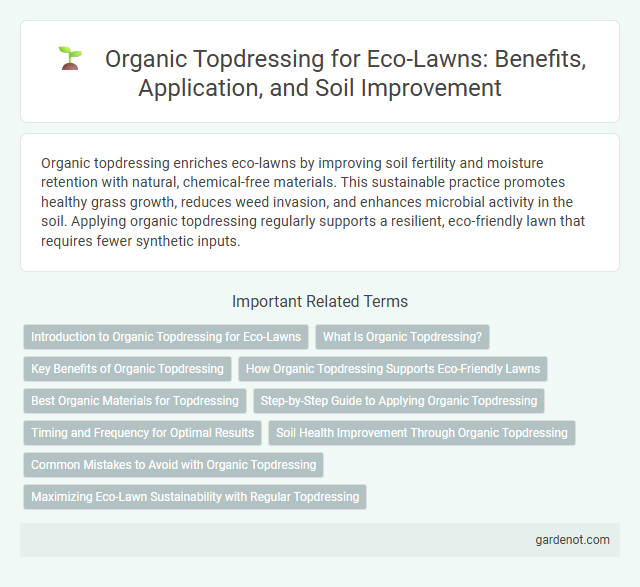Organic topdressing enriches eco-lawns by improving soil fertility and moisture retention with natural, chemical-free materials. This sustainable practice promotes healthy grass growth, reduces weed invasion, and enhances microbial activity in the soil. Applying organic topdressing regularly supports a resilient, eco-friendly lawn that requires fewer synthetic inputs.
Introduction to Organic Topdressing for Eco-Lawns
Organic topdressing for eco-lawns involves applying a thin layer of natural materials such as compost, seaweed, or humus to the lawn surface, enhancing soil structure and microbial activity. This practice improves water retention, promotes nutrient cycling, and supports sustainable lawn health without synthetic chemicals. Consistent organic topdressing encourages deep root growth and increases resilience against drought and pests in eco-lawn environments.
What Is Organic Topdressing?
Organic topdressing involves applying a natural layer of compost or nutrient-rich organic material over the lawn surface to improve soil health and promote healthy grass growth. This technique enhances soil structure, increases microbial activity, and provides slow-release nutrients that reduce the need for chemical fertilizers. Incorporating organic topdressing into eco-lawn maintenance supports sustainable gardening practices and improves long-term turf resilience.
Key Benefits of Organic Topdressing
Organic topdressing enhances soil health by improving nutrient retention and promoting beneficial microbial activity, leading to stronger grass roots and healthier turf. It reduces water runoff and soil erosion, contributing to better moisture absorption and long-term sustainability for eco-lawns. Using organic materials as topdressing supports environmental conservation by minimizing chemical inputs and fostering natural soil regeneration.
How Organic Topdressing Supports Eco-Friendly Lawns
Organic topdressing enhances eco-friendly lawns by improving soil structure, increasing microbial activity, and providing essential nutrients through natural compost materials. This practice reduces reliance on synthetic fertilizers and minimizes water runoff pollution, promoting sustainable lawn care. Furthermore, organic topdressing boosts moisture retention, leading to healthier grass growth and reduced irrigation needs.
Best Organic Materials for Topdressing
The best organic materials for topdressing eco-lawns include compost, seaweed meal, and well-aged manure, which enrich soil structure and promote healthy microbial activity. Compost improves water retention and nutrient availability, while seaweed meal provides essential trace elements and growth hormones that stimulate root development. Well-aged manure contributes vital nitrogen and organic matter, enhancing soil fertility without the risk of burning grass blades.
Step-by-Step Guide to Applying Organic Topdressing
Apply organic topdressing to Eco-lawns by first mowing the grass to a shorter height, allowing the organic material to make direct contact with the soil. Evenly spread a 1/4 to 1/2 inch layer of compost, finely screened to avoid clumps, to nourish soil microbes and improve organic matter content. Water the lawn lightly after application to help the organic nutrients penetrate the soil and enhance grass growth.
Timing and Frequency for Optimal Results
Applying organic topdressing to an eco-lawn is most effective in early spring and late fall when soil microbial activity is high. Frequency should range from one to three times per year to enhance soil health, improve moisture retention, and promote nutrient cycling. Timely application during these periods supports robust root growth and sustainable lawn vigor.
Soil Health Improvement Through Organic Topdressing
Organic topdressing enhances soil health by adding nutrient-rich compost layers that improve soil structure and increase microbial activity. This natural amendment boosts water retention and aeration, promoting root development and resilience against pests. Regular applications of organic topdressing support sustainable lawn ecosystems by replenishing essential nutrients and maintaining balanced soil pH levels.
Common Mistakes to Avoid with Organic Topdressing
Common mistakes to avoid with organic topdressing include applying too thick a layer, which can smother grass and hinder growth, and using improperly composted materials that may introduce weeds or pathogens. Failing to evenly distribute the organic matter can lead to inconsistent nutrient availability and patchy turf health. Regularly monitoring soil moisture and avoiding topdressing during drought conditions helps prevent stress and ensures optimal lawn recovery.
Maximizing Eco-Lawn Sustainability with Regular Topdressing
Regular organic topdressing enhances Eco-Lawn sustainability by improving soil structure, increasing nutrient availability, and promoting healthy microbial activity. This natural layer of compost or finely screened organic material supports moisture retention and reduces the need for synthetic fertilizers and pesticides. Consistent application fosters resilient turf growth and contributes to a thriving, eco-friendly lawn ecosystem.
Organic topdressing Infographic

 gardenot.com
gardenot.com